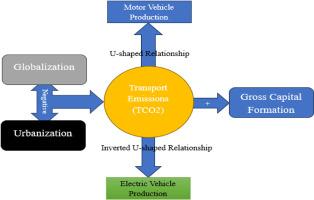脱碳交通:电动汽车生产与传统汽车
IF 6.3
2区 工程技术
Q1 ECONOMICS
引用次数: 0
摘要
努力实现净零目标的国家面临着不断增长的排放带来的重大挑战,排放仍然是环境污染的主要驱动因素。解决这一问题需要评估传统汽车和电动汽车生产的作用。本研究考察了2010年至2022年24个国家的电机和电动汽车生产(EV)在运输碳排放中的作用。本研究采用CS-ARDL方法来解决潜在的横断面依赖性。在STIRPAT框架和环境库兹涅茨曲线假设的激励下,汽车产量与碳排放呈非线性关系。研究结果显示,机动车生产和交通排放之间呈u型关系。具体来说,排放量最初随着产量的增加而下降,但一旦产量超过每年约4436辆,排放量就开始上升,这表明传统车辆的无限制扩张加剧了某些国家的环境恶化。相比之下,电动汽车的生产呈现倒u型曲线:由于能源密集型制造业,早期的扩张会略微增加排放,但每年超过234辆的生产水平会显著减少排放,估计二氧化碳强度会下降14%。此外,资本形成总额增加了运输排放,而全球化和城市化则减少了排放。这些成果符合可持续发展目标11,特别是关于促进可持续交通系统的具体目标11.2和关于减少城市对环境影响的具体目标11.6,强调了汽车生产经济体对更绿色交通和城市基础设施的需求。这项研究强调,在促进电动交通的同时,对传统车辆进行有效监管,对于实现可持续减少交通相关排放至关重要。本文章由计算机程序翻译,如有差异,请以英文原文为准。

Decarbonizing transport: EV production versus conventional vehicles
Countries striving to achieve net-zero targets face significant challenges from growing emissions, which remain a key driver of environmental pollution. Addressing this issue requires evaluating the role of both conventional motor and electric vehicle production. This study examines the role of motor and electric vehicle production (EV) in transport carbon emissions across 24 countries from 2010 to 2022. The study employs the CS-ARDL approach to address the potential cross-sectional dependence. The vehicle production presents a non-linear relationship with carbon emissions, as motivated by the STIRPAT framework and Environmental Kuznets Curve hypothesis. The findings reveal a U-shaped relationship between motor vehicle production and transport emissions. Specifically, emissions initially decline with increased production but begin to rise once output surpasses approximately 4436 units annually, indicating that unchecked expansion of conventional vehicles exacerbates environmental degradation in selected countries. In contrast, EV production exhibits an inverted U-shaped curve: while early-stage expansion slightly raises emissions due to energy-intensive manufacturing, production levels beyond 234 units annually lead to significant emission reductions, with estimates showing up to a 14 % decrease in CO2 intensity. Furthermore, gross capital formation increases transport emissions, whereas globalization and urbanization reduce them. These results align with SDG 11, particularly target 11.2 on promoting sustainable transport systems and target 11.6 on reducing the environmental impact of cities, highlighting the need for greener mobility and urban infrastructure in vehicle-producing economies. This study emphasizes that effective regulation of conventional vehicles alongside the promotion of electric mobility is essential for achieving sustainable reductions in transport-related emissions.
求助全文
通过发布文献求助,成功后即可免费获取论文全文。
去求助
来源期刊

Transport Policy
Multiple-
CiteScore
12.10
自引率
10.30%
发文量
282
期刊介绍:
Transport Policy is an international journal aimed at bridging the gap between theory and practice in transport. Its subject areas reflect the concerns of policymakers in government, industry, voluntary organisations and the public at large, providing independent, original and rigorous analysis to understand how policy decisions have been taken, monitor their effects, and suggest how they may be improved. The journal treats the transport sector comprehensively, and in the context of other sectors including energy, housing, industry and planning. All modes are covered: land, sea and air; road and rail; public and private; motorised and non-motorised; passenger and freight.
 求助内容:
求助内容: 应助结果提醒方式:
应助结果提醒方式:


